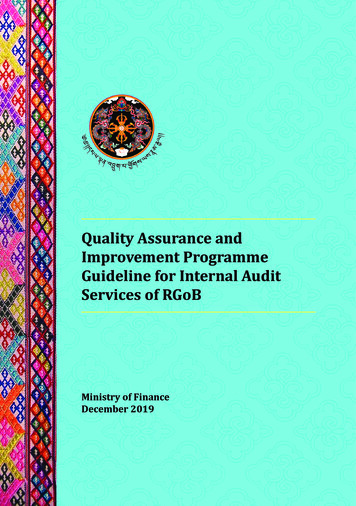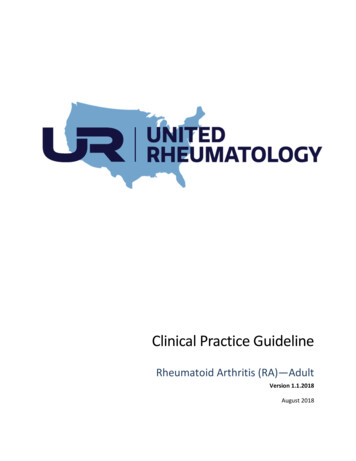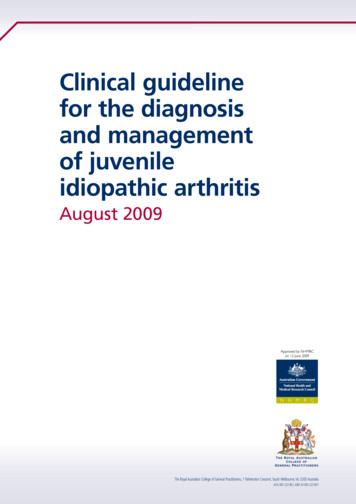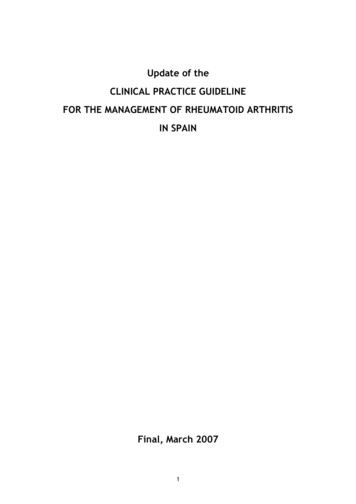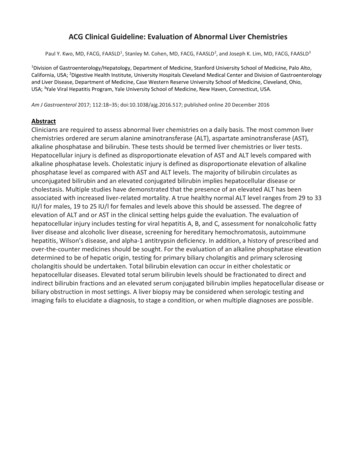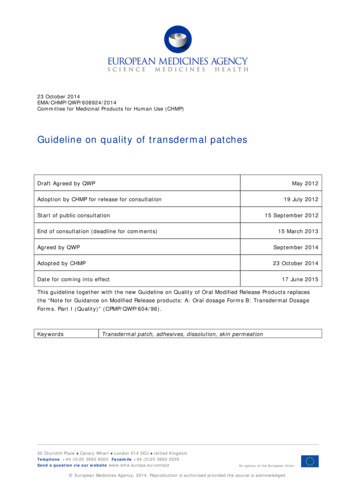
Transcription
23 October 2014EMA/CHMP/QWP/608924/2014Committee for Medicinal Products for Human Use (CHMP)Guideline on quality of transdermal patchesDraft Agreed by QWPMay 2012Adoption by CHMP for release for consultation19 July 2012Start of public consultation15 September 2012End of consultation (deadline for comments)15 March 2013Agreed by QWPSeptember 2014Adopted by CHMP23 October 2014Date for coming into effect17 June 2015This guideline together with the new Guideline on Quality of Oral Modified Release Products replacesthe “Note for Guidance on Modified Release products: A: Oral dosage Forms B: Transdermal DosageForms. Part I (Quality)” (CPMP/QWP/604/96).KeywordsTransdermal patch, adhesives, dissolution, skin permeation30 Churchill Place Canary Wharf London E14 5EU United KingdomTelephone 44 (0)20 3660 6000 Facsimile 44 (0)20 3660 5555Send a question via our website www.ema.europa.eu/contactAn agency of the European Union European Medicines Agency, 2014. Reproduction is authorised provided the source is acknowledged.
Guideline on quality of transdermal patchesTable of contentsExecutive summary . 31. Introduction (background) . 32. Scope. 43. Legal basis . 44. New applications . 54.1. Description and composition of the drug product . 54.2. Pharmaceutical development . 64.3. Manufacture . 154.4. Control of excipients, including layers and liners. 164.5. Drug product specifications. 164.6. Control strategy . 175. Requirements to support a generic or abridged application . 175.1. General remarks . 175.2. Development pharmaceutics . 175.3. Comparative quality and clinical data requirements . 186. Variations applications . 18Definitions . 20References . 22Annex 1 (In vitro permeation studies) . 23Guideline on quality of transdermal patchesEMA/CHMP/QWP/608924/2014Page 2/27
Executive summaryThis guideline addresses new marketing authorisation applications (including generic or abridgedapplications) and subsequent variation submissions for transdermal patches for systemic delivery.Guidance is provided on the quality requirements for the description, development, manufacture,characterisation of excipients, control of drug product, packaging and stability of transdermal patches.In particular, in vitro performance testing with respect to drug release, adhesion and skin permeationis discussed, together with its relation to clinical and in vivo performance.It should be read in conjunction with the Guideline on the Pharmacokinetic and clinical evaluation ofmodified-release dosage forms.Transdermal patches are designed to provide a controlled delivery of the active substance(s) throughthe skin, principally by diffusion, resulting in a defined rate and extent of systemic delivery of activesubstance.1. Introduction (background)An important function of the skin is to protect the body from the external environment, and it isnormally a very effective barrier to the permeation of active substances. However, for certain activesubstances, depending on their physicochemical properties, passive diffusion is possible to achieve atherapeutic effect.Otherwise, this may be achieved by permeation enhancement, which involves the manipulation of theformulation by either: Increasing the thermodynamic activity of the active substance in formulation (e.g., bysupersaturation) Passive penetration enhancement (e.g., solvents can act as a carrier of the active, prodrugs,nanocarriers, microemulsions, liposomes)Permeation enhancement may also be achieved by physical technologies such as iontophoresis,microporation, sonophoresis and microdermabrasion, which could be characterised as activeenhancement strategies.A transdermal patch, which may also be considered a Transdermal Drug Delivery System (TDDS), isdefined as a flexible, multi-layered, pharmaceutical single dose preparation of varying size containingone or more active substances to be applied to the intact skin for systemic absorption. This is normallyformulated with pressure-sensitive adhesives that assure the adhesion of the preparation to the skin. Atransdermal patch includes a backing sheet, impermeable to the active substance and normallyimpermeable to water. The releasing surface of the patch is covered by a protective liner to beremoved before applying the patch to the skin.Transdermal patches are designed to slowly deliver the active substance(s) through the intact skin,resulting in a prolonged and adequately constant systemic absorption rate. The rate limiting step forsystemic absorption of the active substance is usually the absorption through the skin. Alternatively,absorption may be limited by incorporating or dissolving the active substance in a (semi solid)reservoir, with a membrane to control the release and the diffusion of the active substance(s) from thepatch. The transdermal patch can also be formulated combining both drug delivery principles as themeans of controlling drug delivery to the surface of the skin (see also Definitions).Guideline on quality of transdermal patchesEMA/CHMP/QWP/608924/2014Page 3/27
The degree to which formulation and product design may influence active substance permeationthrough the skin may be characterised by means of performance testing (a) dissolution, (b) drugrelease using a synthetic membrane and (c) skin permeation testing. Each has advantages anddisadvantages.The results of dissolution and skin permeation can together inform about the contribution of the patchand the skin in controlling absorption.To ensure the safe and effective use of transdermal patches, the active substance(s) should bedelivered through the skin at an adequate rate that is maintained for an appropriate time during patchapplication and should not irritate or sensitise the skin. The excipients should not have an adverseeffect on the skin or exacerbate the adverse effects of the active substance. Skin enhancers shouldhave a reversible impact on the skin barrier. The solvents used should not interact with thecomponents of the patch system.Transdermal patches usually contain an excess of active substance than that delivered to the patientduring use. This excess is necessary to maintain a clinically effective rate of delivery over time andallow the minimum patch surface area. Because the concentration of the active substance can be nearto its saturation limit, there is a risk of crystallisation on storage with potential adverse effects on thequality and efficacy of the product. Furthermore, the residual active substance left in the patch afteradministration can pose a safety risk to the patients, others and the environment. There is also a riskof misuse of discarded transdermal patches e.g., those containing narcotic drugs.It is acknowledged that transdermal patches can differ in drug content and surface area but still deliverthe same amount of drug over the same period of time. It is desirable to minimise the amount ofresidual active substance in the patch as much as possible.2. ScopeThis guideline considers the general requirements concerning the development and quality of atransdermal patch for all new marketing authorisation applications and variations. In addition, specificguidance is provided concerning the data requirements to support generic or abridged applications.Cutaneous patches (where the active substance is not intended to be systemically absorbed) are out ofthe scope of this guideline. However, some of the quality aspects of transdermal patches may berelevant and applicable, e.g., Sections 4.2 Pharmaceutical Development, 4.3 Manufacture and 4.5 DrugProduct Specifications.Annex 1 provides supplementary information with respect to in vitro skin permeation studies.3. Legal basisThis guideline should be read in conjunction with Directive 2001/82/EC as amended, Directive2001/83/EC as amended and relevant Pharmacopoeial monographs and ICH, CHMP/CVMP guidelinesincluding: Ph. Eur. Monograph 1011 Transdermal Patches; Pharmaceutical Development, ICH Q8 (R2), EMEA/CHMP/167068/2004; Manufacture of the Finished Dosage Form, CPMP/QWP/486/95 and Annex: Start of Shelf-Life of theFinished Dosage Form CPMP/QWP/072/96;Guideline on quality of transdermal patchesEMA/CHMP/QWP/608924/2014Page 4/27
Guideline on Process Validation for finished products. Information and data to be provided inRegulatory Submissions EMA/CHMP/CVMP/QWP/BWP/70278/2012-Rev1; Excipients in the Dossier for Application for Marketing Authorisation of a Medicinal ProductCHMP/QWP/396951/06; Inclusion of Antioxidants and Antimicrobial Preservatives in Medicinal ProductsCPMP/CVMP/QWP/115/95; Q 6A Specifications: Test Procedures and Acceptance Criteria for New Drug Substances and NewDrug Products: Chemical Substances CPMP/ICH/ 367/96-ICH Q6A; Q 2(R1) Validation of Analytical Procedures: Text and Methodology, CPMP/ICH/381/95 - ICH Q2(R1); Stability Testing of New Drug Substances and Drug Products (ICH Q1A (R2)), CPMP/ICH/2736/99ICH Q1A (R2); Stability Testing: Requirements for New Dosage Forms (ICH Q1C), CPMP/ICH/280/95-ICH Q1C; Stability Testing of Existing Active Ingredients and Related Finished Products, CPMP/QWP/122/02Rev. 1 corr.; Guidelines of 16.05.2013 on the details of the various categories of variations, on the operation ofthe procedures laid down in Chapters II, IIa, III and IV of Commission Regulation (EC) No1234/2008 of 24 November 2008 concerning the examination of variations to the terms ofmarketing authorisations for medicinal products for human use and veterinary medicinal productsand on the documentation to be submitted pursuant to those procedures (C (2013) 2804); and Guideline on the pharmacokinetic and clinical evaluation of modified release dosage forms(EMA/CPMP/EWP/280/96 Corr1).4. New applicationsThe data requirements discussed below are relevant to new applications for the first use of the activesubstance for systemic delivery using a transdermal patch and new generic or abridged applications.Additional requirements for generic or abridged applications, in lieu of full clinical data, are given inSection 5 Requirements to support a generic or abridged application.4.1. Description and composition of the drug productThe description should be in sufficient detail to fully characterise the drug product (all strengths) andinform the relevant quality sections of the SmPC and, as appropriate, the package leaflet and labelling.The product description should include the following: Strength, as the mean dose delivered per unit time, normally mass delivered in vivo per 24 hours; In vivo release rate or strength per patch area (i.e. mass delivered in vivo/unit area/unit time); The content and location of active substance in the drug product; Active substance utilisation (% of total active substance absorbed per patient administration); Patch area activity (active substance utilisation/patch area);Guideline on quality of transdermal patchesEMA/CHMP/QWP/608924/2014Page 5/27
Residual (mass of active substance remaining in the drug product after completion ofadministration); Instructions for use, including the use of any overlay; and Patch period of use.Unambiguous tabular formats, any necessary schematics (preferably supported by photographs)should be provided to describe the following: Patch type, with respect to the control of drug release (e.g., reservoir, drug in adhesive); The form and function of each layer of the laminated product; The composition of each layer, including the function and the grade of the excipient (the grade isnormally considered to be a critical quality attribute for transdermal delivery). Backing layers andrelease liners should also be described; Overlay description (if applicable); Patch size, area and thickness (area weight may be considered if justified); and Appearance, including shape, colour and markings.Drug product design aspects relating to patient administration and use throughout the period of useshould also be described.Transdermal patch design should avoid cutting by patients or health care professionals – a smallertransdermal patch should be developed instead.However, in exceptional cases for good patient safety and efficacy reasons, cutting might benecessary. In such cases this should be described and supportive data should be given in 3.2.P.2 aswell as in the clinical dossier.The names of excipients not described in a Pharmacopoeia should be specific and distinct and shouldbe supported by a brand name or name and address of manufacturer, if necessary.The primary packaging and, if necessary, secondary packaging or other materials or componentsrequired for reasons of stability, should be described.Some elements of the description of the drug product such as product strength, active substanceutilisation, residual and suitability of administration and use cannot be directly or indirectly (usingsurrogate markers) determined by quality tests. The determination and/or assessment of these qualityelements can only be achieved by appropriate valid clinical studies. The description should thereforeinclude cross references to other sections of the dossier that describe their determination and/orassessment, together with evidence of the validity of the clinical methods.4.2. Pharmaceutical developmentThe pharmaceutical development component of the dossier should form a sound basis of the suitabilityof the transdermal patch for its intended use, provide a clear narrative of product development andinclude all relevant data.Guideline on quality of transdermal patchesEMA/CHMP/QWP/608924/2014Page 6/27
4.2.1. Therapeutic objectives and principle of the delivery systemA summary of the therapeutic objectives and rationale for the choice of the transdermal route for theactive substance, in terms of patient benefit / risk, should be provided.Factors to be considered should include therapeutic use, local and systemic side effects associated withother routes, pharmacodynamics, pharmacokinetic properties of the active substance (e.g. t1/2,therapeutic index, first pass-effect).Local tolerance, the means of administration (including occlusion, if relevant), administration site,posology, patient compliance in medication taking and the proportionality of different strengths shouldalso be discussed.Where appropriate, cross references to relevant clinical sections of the dossier should also be given.The achievement of the therapeutic objectives by the design and function of the transdermal patchshould be fully discussed and correlate with the Description and Composition of the Drug Product e.g.,the identification and description of the type of transdermal patch (e.g. reservoir, drug in adhesive)and how drug release over the intended time of application is achieved.4.2.2. Active substanceActive substance physicochemical and biological properties that determine the capability and / orinfluence the rate and extent of transdermal delivery and the manufacturability and stability of thedrug product should be identified and discussed. Such properties include molecular weight, partitioncoefficient, melting point (boiling point if applicable), pKa, solubility and pH effects, as well as physicalproperties, such as particle size and polymorphism, if the active substance is present in the solid statein the drug product.The target physical state of the drug substance, e.g. solute, suspension, and the degree of saturationor supersaturation are critical quality attributes and should be justified in terms of product efficacy andsafety, supported by evidence of the means by which the target state is achieved during manufactureand its stability during storage.The risks of precipitation / particle growth / change in crystal habit, or other active substancecharacteristics likely to affect the thermodynamic activity, arising from changes in temperature and onstorage should be assessed and appropriate tests included in the stability studies.These properties could be inter-related and might need to be considered in combination.4.2.3. ExcipientsThe choice of excipients (including the adhesives, backing layer and release liners and rate controlmembrane), their concentration, and their characteristics that can influence the drug productperformance should be discussed relative to their respective functions.Detailed information on those materials which might have an influence on the adhesive properties andactive substance transdermal permeation and bioavailability (e.g. solubiliser, penetration enhancer orretarder) should be provided, including their ability to provide their intended functionality and toperform throughout the intended drug product shelf life (see also the Note for Guidance “Excipients inthe Dossier for Application for Marketing Authorisation of a Medicinal Product” CHMP/QWP/396951/06Annex III).Guideline on quality of transdermal patchesEMA/CHMP/QWP/608924/2014Page 7/27
For patches utilising a rate controlling membrane, the suitability and performance of the ratecontrolling membrane should be fully discussed.The relevant characteristics of the layers (backing layer, the release liner, rate controlling membranesand adhesive liner), such as appearance, flexibility, tensile strength, porosity, occlusion and chemicalinertness, and the other excipients should be discussed. This information can be used, as appropriate,to justify the choice and quality attributes of the excipients, their specification and safety (3.2.P.4.4and 3.2.P4.6) and to support the drug product specification (3.2.P.5.6).The composition and relevant characteristics of excipient mixes, e.g. adhesive solutions orsuspensions, should be provided and characterised, including viscoelastic properties, if appropriate.Processing aids, including temporary lamination layers and solvents employed during manufacture,which are subsequently removed, should be identified and described.4.2.4. Formulation developmentA summary describing the development of the drug product should be provided. This should clearlyand critically describe the means by which each of the defined quality product elements, given in3.2.P.1 (see Section 4.1 above), were determined and achieved.The development of the drug product should be described with respect to the defined quality targetproduct profile, employing suitable tests to characterise and control the critical quality attributes,including adhesion properties, factors affecting ease of administration and duration of use, and productperformance (dissolution, in vitro drug release, in vitro skin permeation).Satisfactory evidence of the suitability of the methods employed should be
ich q1a (r2); Stability Testing: Requirements for New Dosage Forms (ICH Q1C), CPMP/ICH/280/95- ICH Q1C; Stability Testing of Existing Active I
